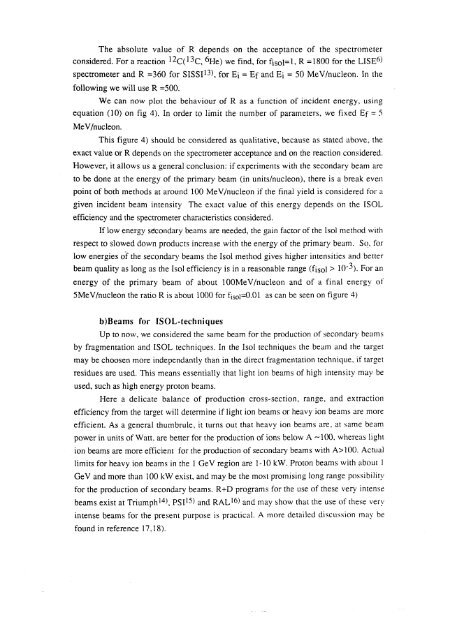Radioactive beams by fragmentation and ISOL techniques - CERN
Radioactive beams by fragmentation and ISOL techniques - CERN
Radioactive beams by fragmentation and ISOL techniques - CERN
You also want an ePaper? Increase the reach of your titles
YUMPU automatically turns print PDFs into web optimized ePapers that Google loves.
The absolute value of R depends on the acceptance of the spectrometer<br />
12136<br />
considered. For a reaction C(C, He) we find, for fiSOi=1, R :1800 for the LISEO<br />
spectrometer <strong>and</strong> R :360 for SISSI13), for Ei = Ef <strong>and</strong> Ei : 50 MeV/nucleon. ln the<br />
following we will use R :500.<br />
MeV/nucleon.<br />
We can now plot the behaviour of R as a function of incident energy, using<br />
equation (10) on fig 4). In order to limit the number of parameters, we fixed Ef : 5<br />
This figure 4) should be considered as qualitative, because as stated above, the<br />
exact value or R depends on the spectrometer acceptance <strong>and</strong> on the reaction considered.<br />
However, it allows us a general conclusion: if experiments with the secondary beam are<br />
to be done at the energy of the primary beam (in units/nucleon), there is a break even<br />
point of both methods at around 100 MeV/nucleon if the final yield is considered for a<br />
given incident beam intensity The exact value of this energy depends on the <strong>ISOL</strong><br />
efficiency <strong>and</strong> the spectrometer characteristics considered.<br />
lf low energy secondary <strong>beams</strong> are needed, the gain factor of the lsol method with<br />
respect to slowed down products increase with the energy of the primary beam. So, for<br />
low energies of the secondary <strong>beams</strong> the lsol method gives higher intensities <strong>and</strong> better<br />
beam quality as long as the lsol efficiency is in a reasonable range (fisoi > 10*). For an<br />
energy of the primary beam of about 100MeV/nucleon <strong>and</strong> of a final energy of<br />
5MeV/nucleori the ratio R is about 1000 for fiSOi:0.0l as can be seen on figure 4)<br />
b)Beams for <strong>ISOL</strong>-<strong>techniques</strong><br />
Up to now, we considered the same beam for the production of secondary <strong>beams</strong><br />
<strong>by</strong> <strong>fragmentation</strong> <strong>and</strong> <strong>ISOL</strong> <strong>techniques</strong>. In the lsol <strong>techniques</strong> the beam <strong>and</strong> the target<br />
may be choosen more independantly than in the direct <strong>fragmentation</strong> technique, if target<br />
residues are used. This means essentially that light ion <strong>beams</strong> of high intensity may be<br />
used, such as high energy proton <strong>beams</strong>.<br />
Here a delicate balance of production cross-section, range, <strong>and</strong> extraction<br />
efficiency from the target will determine if light ion <strong>beams</strong> or heavy ion <strong>beams</strong> are more<br />
efficient. As a general thumbrule, it turns out that heavy ion <strong>beams</strong> are. at same beam<br />
power in units of Watt. are better for the production of ions below A ~100. whereas light<br />
ion <strong>beams</strong> are more efficient for the production of secondary <strong>beams</strong> with A>l()0. Actual<br />
limits for heavy ion <strong>beams</strong> in the 1 GeV region are 1-10 kW. Proton <strong>beams</strong> with about 1<br />
GeV <strong>and</strong> more than 100 kW exist, <strong>and</strong> may be the most promising long range possibility<br />
for the production of secondary <strong>beams</strong>. R+D programs for the use of these very intense<br />
<strong>beams</strong> exist at Triumphm), PSIIS) <strong>and</strong> RAU6) <strong>and</strong> may show that the use of these very<br />
intense <strong>beams</strong> for the present purpose is practical. A more detailed discussion may be<br />
found in reference 17.18). OCR Output















